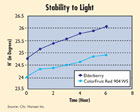

When the colorant’s light stability was compared to an elderberry extract, it had a smaller change in shade or hue (H°).
The color additives used to color food are classified as follows: certified, or synthetic colors, such as FD&C Red 40 and FD&C Yellow 5; and “exempt from certification,” or natural colors. Natural colors include products like annatto, (sourced from seeds), turmeric (sourced from roots) and anthocyanins (sourced from fruits and vegetables). Synthetic colors are manufactured using chemical reactions of highly purified aromatic compounds, such as naphthalene. Natural colors are typically extracted or expressed from an approved natural source.
In the ColorFruit™ range of products by Chr. Hansen, anthocyanins from different sources are combined to obtain a specific shade and/or specific stability in food applications. Anthocyanins give fruits and flowers their red to blue colors in nature, and the shades they provide in applications range from yellowish-red to bluish-red. The ColorFruit line provides enhanced stability in applications through the use of proprietary technology that optimizes the intermolecular and intramolecular interactions between anthocyanin molecules.
“The uniqueness of our ColorFruit products is that they can be used in a wide variety of low pH applications with improved stability,” says Madkins. The applications for these colors include beverages with or without ascorbic acid, fortified beverages, fruit preparations, confectionery, yogurt and frozen novelties.
In order to study the improved light stability of ColorFruit, colorant concentrations were adjusted in soft drink media (pH 3.0, 10 brix, with or without ascorbic acid) by colorimeter and then exposed to accelerated light stability testing in a light cabinet during 6, 12 and 24 hours. In order to study the improved heat stability, the colorant was again evaluated in the same soft drink mixture at pH 3.0 and adjusted to initial lightness using a colorimeter. Each preparation was then placed in a dark, hot air steam cabinet at 50°C. In order to evaluate the improved stability to vitamin C, the colorant was placed in a similar soft drink medium containing ascorbic acid and tested in a dark condition at 50°C and then measured colorimetrically. Delta E (total color change) and Hº (hue or shade) changes were measured. The results of the tests demonstrated that this line of coloring products exhibits improved stability to light, heat and vitamin C compared to more standard products. (See chart “Stability to Light.”)
When choosing a ColorFruit product, Madkins suggests a client determine the shade required for the final application. Once decided, the parameters of the application medium, such as pH, processing parameters, the presence of ascorbic acid and other key interactive ingredients are noted. The optimal ColorFruit product that corresponds to the shade and required application stability can then be provided with assistance from the Chr. Hansen development team.
For more information:
Chr. Hansen Inc., Milwaukee • Byron D. Madkins • 414-607-5753
bmadkins@chr-hansen-us.com•www.chr-hansen.com